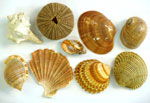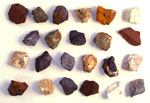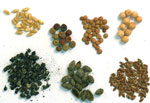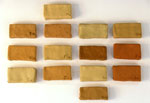Comparative Collections
Scientific research on archaeological materials is greatly assisted by the growing reference collections housed within the Wiener Laboratory. There is no substitute for the opportunity to examine and experiment on physical comparanda. A number of comparative collections have already been developed and are constantly being added to, while new collections to support emerging areas of research are being planned. A virtual faunal reference collection will also be available soon. Additionally, the laboratory's extensive specialist library holdings offer access to journals not available elsewhere in Greece, as well as maps and other resources.
The Wiener Laboratory's permanent reference collections benefit from the contributions of both time and materials by lab staff, fellows and associates, excavators, interested scholars and colleagues at other research institutions. All donations are gratefully received.
The Wiener Laboratory experimental garden
Since 2016, Wiener Lab staff and ASCSA Members have used a small part of the ASCSA Lower gardens to create an experimental garden dedicated to the cultivation of plants used in the Greek world since antiquity. This allows for an understanding of crop cycles, and the produced seeds, seed husks, some stems and leaves are preserved in the Wiener Lab comparative collections. These materials are available both for identification of macroscopic and microscopic plant remains, as well as for conducting experiments allowing for a better understanding of anthropogenic and taphonomical alterations of plant materials. The garden is fertilized only with manure and nitrogen fixing plants. On occasions, experimentally produced stone tools were used for harvesting plants, and these tools are also part of the Wiener Lab comparative collections as they preserve traces that could be used in identifying use-wear patterns in archaeological stone tools. From 2016 until present we have grown wheats (Triticum monococcum, T. dicoccum and T. spelta), barley (Hordeum vulgare), flax (Linum usitatissimum), faba beans (Vicia faba) and grass pea (Lathyrus sativus). Soil samples are also kept, after each planting season, to allow for a future study of soil chemistry fluctuations.
3D Collection
The 3D digital comparative collection includes high resolution models of skeletal elements of vertebrates from the Lab collections. The viewing platform allows for the full manipulation of the models by the user and includes tools for making linear measurement, or for measuring angles of anatomical features. This growing collection will become an essential resource for specialists working in remote areas with no access to modern comparative material.
Browse the CollectionHuman Skeletal Collection
The Human Skeletal collection housed in the Wiener Laboratory consists of a small number of complete skeletons and various isolated skeletal elements, as well as numerous casts (e.g., articulated and non articulated plastic skeletons). In addition, the collection includes casts of human dental development (maxillae and mandibles), the Arizona State University Dental Anthropology System reference plaques, the Suchey-Brooks pubic symphyseal aging system casts, and the Işcan et al. rib phase casts. Finally a modern human dental reference collection already consisting of 270 specimens is under development and available to researchers.
Modern Faunal Comparative Collection
 This growing collection concentrates on the basic mammal, mollusc, fish and bird species common to Greece and the Eastern Mediterranean.
This growing collection concentrates on the basic mammal, mollusc, fish and bird species common to Greece and the Eastern Mediterranean.
Lithic Collection
The Lithic Reference Collection includes specimens of both hand samples and thin sections.The collection further includes a stable isotope database for Aegean marbles,  reference samples of oolitic limestone from Greek and Roman quarries at Corinth, marble samples from Mount Pentelikon and quarry regions around the Peloponnese.
reference samples of oolitic limestone from Greek and Roman quarries at Corinth, marble samples from Mount Pentelikon and quarry regions around the Peloponnese.
Botanical Collection
This is a growing Botanical Collection consisting of :
• An extensive seed and plants reference collection. For a catalogue of the collection click here
• A modern reference collection of charred wood
• A digital archive of phytoliths
Ceramic and Soil Collections
A part of Marie Farnsworth’s Ceramic Collection is on permanent loan from the Smithsonian Institution. The lab also has a small Soil Micromorphological Reference Collection of  archaeological and natural sediments from the Palaeolithic sequence of Theopetra Cave, situated near Meteora in Northern Greece and a small number of petrographic thin sections from Markiani on Amorgos.
archaeological and natural sediments from the Palaeolithic sequence of Theopetra Cave, situated near Meteora in Northern Greece and a small number of petrographic thin sections from Markiani on Amorgos.
Other Collections
Other collections include a large Pigment Collection, Modern Bone Tool and Stone Tool Collections.
Please consult our Rights and Permissions page for details on using images from our collections.
The Wiener Laboratory owes special thanks to the following for their contributions to its reference collections: Peter Allen, Niels Andreasen, Philip Betancourt, Harriet Blitzer, Hariclia Brecoulaki, Zoi Chalatsi, Rozalia Christidou, Heidi Dierckx, Keith Dobney, Yiannis Hamilakis, Chris Hayward, Norman Herz, Elissavet Hitsiou, George Kacandes, Panagiotis Karkanas, Walter Klippel, Anna Lagia, Justin Lev-Tov, Maria Liston, Evi Margaritis, Fragkiska Megaloudi, Calla McNamee, Dimitrios Michailidis, Michele Miller, Melissa Moore, Jenifer Neils, James Newhard, Maria Ntinou, Scott Pike, Katerina Papayiannis, Paul W. Parmalee, Eleanna Prevedorou, George Rapp, Deborah Ruscillo, China Shelton, Christine Shriner, Ruth Siddall, Lynn Snyder, Tatiana Theodoropoulou, Ekaterini Trantalidou, Georgia Tsartsidou, Sarah Vaughan, Rena Veropoulidou, Chantel White and John Younger.
